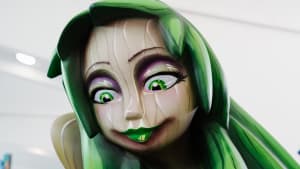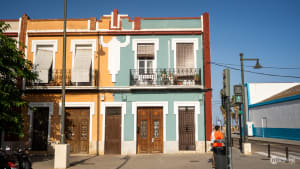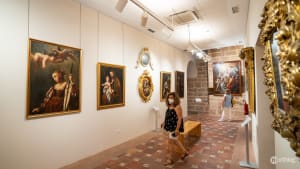
Fallas Clothing
Bright colours, rich fabrics, endless details and meticulous embroidery. These are the clothes worms by falleras and falleros during Fallas.
Fallas Clothing in a nutshell…
Fallas is as vibrant in fashion as it is in fireworks! Falleras dazzle in corset-style bodices, full embroidered skirts, and intricate braided hairdos with a peineta. The Fallera Mayor stands out with a unique silk gown and an optional sash.
Falleros wear traditional trousers, embroidered waistcoats, colorful sashes, and espadrille-style shoes, often topped with a handkerchief or hat.
These stunning, handcrafted outfits bring history, culture, and elegance to Valencia’s most spectacular festival!
The dresses worn by falleras and falleros during the Fallas festival, especially during parades and official events such as the Ofrenda de Flores, are based on regional 18th and 19th centuries clothing.
These garments shouldn’t however be considered to represent exactly how women and men, especially the huertanos (people that worked in the orchards and fields) dressed at the time.

Rather, these are costumes that have been chosen to represent the regional festivity outfit, the fallas festival, and its participants at large. In any case, the historical accuracy of each outfit and how its pieces are put together are usually left to the personal taste of the fallera or fallero wearing them.
Valenciana dress
The traje de valenciana (Valenciana dress), sometimes also called a traje de fallera (fallera costume) is the outfit worn by falleras during Fallas and other important events or festivities in the region. Much like men’s clothing, Valenciana dresses are inspired by 18th and 19th-century fashion. However, the women’s outfit is also completed by a specific hairdo and hair accessories, as well as jewellery.
During Fallas, especially during the Semana Fallera (15th-19th March), you’re likely to see women and girls wearing these elaborate outfits in the street. Some of them might even be sporting the hairdo in their regular clothes - which admittedly creates a funny juxtaposition.
These outfits are generally tailor-made for each fallera by a specialised workshop, of which there are quite a few in Valencia. For this reason, these dresses are very expensive. Prices can go from a minimum of €2,000 up to €12,000, with the average dress falling somewhere around €6,000. Of course, some decide to sew the pieces themselves or buy them second-hand. In this case, prices average at €300.

Now, even if some dresses are perfectly matched, they are usually made as two separate pieces for the lower and upper body, with specific undergarments.
Undergarments
- Camisa: This is a shirt, made of linen or cotton, which covers the body from the shoulder to the knees, flaring out towards the bottom. The sleeves are either below or above the elbow. The neckline is usually square and sometimes decorated.
- Enaguas: The petticoat, used to add volume to the lower body. This garment’s lower hem is usually decorated. A faltriquera, a small fabric pouch, can be tied on top of the petticoat, to use as an add-on pocket.
- Crinoline: This metal structure, although not very historically accurate for 18th-century clothing, is sometimes added underneath the petticoat to create more volume and hold out the outer skirt.
Lower body
- Guardapiés: this is the outer skirt, usually made of silk, with elaborate floral or plant-themed patterns. It can be decorated with ribbons or other kinds of embroidery.
- Delantal: this is the apron-like piece that covers the front of the skirt. It is usually made of cotton or silk, and it can be more or less sheer, embroidered or ornamented with lace, sequins, or stitches.
Upper body
The women usually choose between one of two types of bust pieces, both quite structured and form-fitting. They can either match the pattern or contrast with the guardapiés.
- Justillo: This is a sleeveless, corset-like piece. The neckline may be square or round, and the fabric is normally silk. To support the body, the piece is laced and reinforced with metal.
- Jubón: This piece is pretty much the same as the justillo, except that it has long sleeves, either to the wrist, forearm, or elbow. This too can be made of silk or velvet and reinforced with metal wires.
- Pañuelo: This is a small square piece of fabric, folded diagonally, used to cover the shoulders and neckline. The handkerchief can be decorated with lace, sequins, and embroidery, much like the delantal.
Accessories
- Jewellery: The women often wear earrings - many representing grape clusters - and necklaces.
- Footwear: The shoes are normally wide-heeled and can match the fabric of the skirt.
- Hair: The falleras wear specific hairdos, often with a braided bun in the back and occasionally the addition of two side buns. The hair is held in place thanks to the peineta and two rascamonyos.
Fallera Mayor dress
The general structure and components of a Fallera Mayor’s dress are broadly the same as those of a regular fallera. Only a couple of elements really distinguish the Fallera Mayor from other falleras.

Since 2001, the Fallera Mayor de Valencia has had to wear a specific fabric, whose floral design was chosen by the Junta Central Fallera (JCF). The fabric is referred to as the official espolín de Fallera Mayor de València.
Espolín is a specific silk fabric made by hand with a wooden loom. So every year, the elected queen gets to wear a fabric design reserved exclusively for Falleras Mayores who represent the city. Bets are often placed on which colours she will choose to make her dress.
The other distinctive element is the sash in the colours of the Valencian flag (red and yellow stripes with a blue band). However, the sash is not mandatory, so the choice of whether to wear it or not is left to the Fallera Mayor’s preference. All falleras mayores (the committees’ representatives as well as the city’s representative) can wear these sashes.
Men’s outfit
Much like the women’s clothing, Valencian men’s folk costumes are inspired by clothing of the 18th century to the 20th century. Also similarly to women’s clothing, historical accuracy is not always strictly respected, and different variations of the outfit can be seen.
The main style influences on this type of clothing are Anglo-French and Moorish-Balkan. Western European fashion was mainly copied by the Spanish ruling minority, and thus some fashion patterns were slowly and partly adopted by the working-class majorities.

Some other pieces instead, like the saragüells, are clearly inherited from Mediterranean traditional clothing, and bear a resemblance to some types of Albanian, Greek, and even Turkish traditional trousers. Here are all the pieces you might see being worn by the falleros, especially during parades such as the Ofrenda de Flores.
Undergarments
- Camisa: A long and loose shirt made of linen or cotton, with long cuffed sleeves. It is sometimes decorated or embroidered at the front.
- Calzoncillo or calçotet: Loose linen or cotton breeches used to cover the body from the waist to the knees at least.
Trousers
You will probably see the falleros wearing one of these two garments on their lower body.
- Saragüell: A very loose type of trouser made of cotton or linen. It normally reaches just above the knee. It is sometimes paired with a negrilla, a black or darker trouser placed on top of the saragüell.
- Torrentí or calçò: It is a more fitted type of trouser, usually in wool, cotton, or even silk. It generally reaches under the knee and has slits to the side, often tied up with buttons or laces. They are often black, brown or blue.
Upper body
- Chaleco or jopetí: A fitted waistcoat, usually in silk, cotton, velvet or wool. The pattern is usually more elaborate than the other basic pieces, with stripes, flowers, or other braided decorations.
- Chupa or jupa: A short jacket with long, narrow sleeves, usually in wool, cotton, velvet or silk.
Accessories
- Faixa: A large and usually colourful sash that holds the saragüell or calçò up.
- Pañuelo: A silk or cotton handkerchief worn on the head.
- Hats: They can be monteras, rodinas, or calanyés.
- Stockings: Usually extremely colourful, made of silk, wool or cotton, these stockings are used to cover the leg up to the knee.
- Zapatillas de esparto or alpargatas: Espadrille-type of footwear, made of leather or fabric and jute.
- Manta: Traditional thick blankets made of wool, worn on top of the clothes as shawls or on the shoulder. They can be mantas morellanas (the most colourful ones, usually with horizontal stripes and small patterns) or de Bocairent (windowpane or checkered patterns).
Frequently Asked Questions
Here you can find quick answers to all of your questions. Linked, you’ll find the articles or the sections of the articles that can give you more detailed information.
-
Yes, especially during official ceremonies and parades, like in the Ofrenda de Flores, the Crida, and sometimes on the day of the Cremà.
If you want to know more about the Valenciana dress and its garments, you can read the relevant section of this article.
-
Yes, especially during official ceremonies and parades, like in the Ofrenda de Flores.
-
Even though the dresses (both women’s and men’s) are based on the regional clothes of the 18th and 19th centuries, historical accuracy is not always respected.
Especially considering that a lot of people, called huertanos, were working in the fields and orchards, and would thus not be wearing elaborate and embroidered dresses.
-
The Fallera Mayor wears a typical Valenciana hairdo and dress like all other falleras. What distinguishes her are only a couple of elements.
One is the design of her silk gown, which only the Fallera Mayor can wear. The other is the Valencian flag sash, but that is not mandatory.
If you want to know more about the Fallera Mayor’s dress, you can check the relevant section of this article.
-
The falleras wearing a Valenciana dress usually wear a guardapiés, a delantal, a justillo or a jubón, a pañuelo, plus the jewellery, heeled shoes, and 18th-century style undergarments.
If you want to know more about the Valenciana dress and its garments, you can read the relevant section of this article.
-
The falleros wearing traditional regional clothing usually wear a saragüell or calçò, a jopetí, a jupa, a faixa, a pañuelo, stockings, and possibly a hat and manta.
The look is completed by alpargatas shoes and 18th-century style undergarments.
If you’d like to know more about these clothes, check out the relevant section of this article.
-
Yes, they wear elaborate hairdos when wearing the Valenciana costume. They can wear a unique braided bun in the back, or add side buns.
The hair is also decorated and kept in place with gold pieces.



















